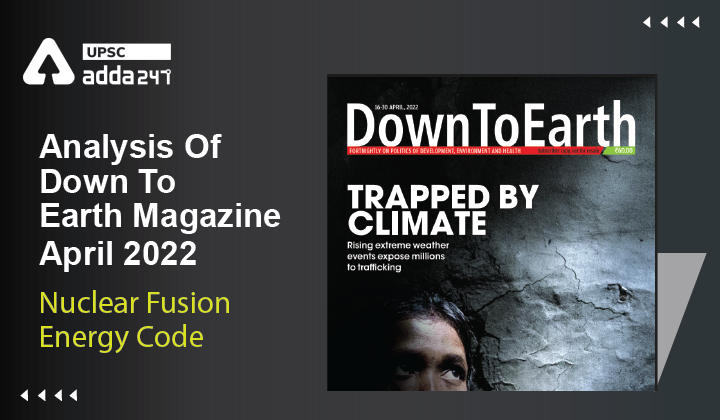Table of Contents
Analysis Of Down To Earth Magazine
”Nuclear Fusion Energy Code”
Context
- The world is close to cracking the nuclear fusion energy code, a source of virtually endless clean energy.
- On December 21 last year, the world moved a step closer to mastering this energy process that powers our sun and stars.
- A laboratory in the UK generated 12 MW over five seconds through fusion, more than doubling its own record of 1997. The energy is enough to power 35 homes for five seconds.
Fusion vs Fission
The fusion of atoms of two heavier isotopes of hydrogen-deuterium and tritium — for example, to form a helium nucleus produces four times as much energy as is released during the fission of a uranium atom, the kind of which we see in our nuclear reactors.

Key Challenges
- Despite being known for some 70 years Nuclear fusion as a source of energy has never become viable.
- Scientists have been making efforts to build a fusion nuclear reactor for several decades, but the challenges are high.
- Fusion is possible only at very high temperatures, of the order of a few hundred million degrees Celsius, the kind of temperature that exists at the core of the Sun and the stars.
- In the sun, massive gravitational pressure enables nuclear fusion at around 10 million degrees Celsius.
- On Earth, where the pressure is much lower, the temperature required is above 100 million degrees Celsius. No material can survive such heat.
- Recreating such extreme temperatures is no easy task.
- The materials that will make up the reactor, too, need to be able to withstand such huge amounts of heat. There are several other complications.
About ITER Project
- ITER is a bigger and advanced version of the Joint European Torus reactor(JET) being built in France with the participation of 35 countries, including China, the EU, India, Japan, South Korea, Russia and the US.
- The ITER project began in 1985 and the deadline for its first experimental run has been extended several times.
- According to the current timeline, it is expected to become operational only in 2035.
- Right now, the reactor is in the machine assembly phase.
- Over ten million parts, being manufactured and tested in the seven-member countries, have to be transported, assembled and integrated.
- Still, ITER is only an experimental project.
- The energy it will produce — about 500 MW — would not be in the form of electricity that can be used.
- It will be a technology demonstration machine that will enable the building of futuristic fusion devices that can be run as normally as the fission reactors today.
- The deployment of fusion energy for electricity generation for our everyday needs might take another few decades after ITER becomes operational.
India and ITER
- India joined the ITER project in 2005.
- The Institute for Plasma Research in Ahmedabad, a laboratory under the Department of Atomic Energy, is the lead institution from the Indian side participating in the project.
- As a member country, India is building several components of the ITER reactor, while also carrying out a number of experiments and R&D activities related to the project.
Key Benefits Of Nuclear Fusion Energy
- Nuclear fusion can be a source of virtually endless energy and is considered comparatively green.
- The fuel deuterium is freely available in seawater, while tritium is a byproduct of nuclear fission, already happening in power plants across the world.
- Per unit of fuel, fusion releases four million times more energy than the combustion of coal, oil or gas, and the only waste is helium— an inert gas with no global warming potential.
- In comparison, fossil fuels would have required 10 million times more fuel to generate the same amount of energy, that is about 1.06 kg of natural gas or 3.9 kg of lignite coal.
- So, with tiny amounts of readily available fuels, we could meet humanity’s energy needs for a long time.



 TSPSC Group 1 Question Paper 2024, Downl...
TSPSC Group 1 Question Paper 2024, Downl...
 TSPSC Group 1 Answer key 2024 Out, Downl...
TSPSC Group 1 Answer key 2024 Out, Downl...
 UPSC Prelims 2024 Question Paper, Downlo...
UPSC Prelims 2024 Question Paper, Downlo...
